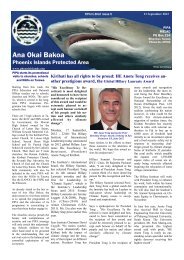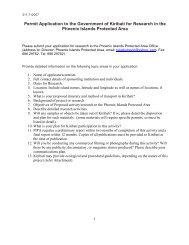Nomination for a World Heritage Site 2009 - Phoenix Islands ...
Nomination for a World Heritage Site 2009 - Phoenix Islands ...
Nomination for a World Heritage Site 2009 - Phoenix Islands ...
You also want an ePaper? Increase the reach of your titles
YUMPU automatically turns print PDFs into web optimized ePapers that Google loves.
the parrotfish on the outgoing tide. Within the group, a few fish swam faster and shook,<br />
stimulating the entire school to spiral and bolt upward, releasing ecstatic bursts of eggs and<br />
sperm along the way like biological fireworks. The egg and sperm clouds they left behind<br />
were so dense they dulled the penetration of sunlight through the water. Again and again the<br />
fish repeated this act, spiralling toward the surface every ten to fifteen seconds. For almost<br />
an hour the school exploded in a rite of reproduction, relying on the fast ebb tide to carry the<br />
fertilized eggs far out to sea, where they would be safer from predators. As I watched from<br />
the seafloor, a large shadow passed over me. A half-ton manta ray, hovering magically and<br />
somehow unmoved by the current, was feeding serenely on the parrotfish eggs and sperm.<br />
Too soon, our nearly empty air tanks <strong>for</strong>ced us to return to the surface and our waiting skiff.<br />
"Incredible—I've never seen anything like<br />
it!" said David Obura, a specialist in coral<br />
reefs who has spent more than a thousand<br />
hours underwater studying ocean life. I also<br />
was deeply moved. As vice president <strong>for</strong><br />
global marine programs at the New England<br />
Aquarium, I've made it my goal to find<br />
Earth's last pockets of primal ocean, those<br />
underwater havens that have remained<br />
unspoiled as long as the ocean can<br />
remember. Here in this lagoon we had<br />
discovered such a place.”<br />
37<br />
Photo Credit: David Obura<br />
Dr. Jim Maragos, the world renowned coral reef scientist from the US Fish and Wildlife<br />
Service, has been diving all over Pacific <strong>for</strong> over 40 years. He quotes: "The <strong>Phoenix</strong> <strong>Islands</strong><br />
Protected Area is the single-most important conservation achievement in the modern history<br />
of Oceania. The Republic of Kiribati, a nation of low islands and atolls, made this noble<br />
commitment. The importance of the eight mostly uninhabited <strong>Phoenix</strong> <strong>Islands</strong> and atolls in<br />
the Protected Area include near pristine coral reefs, deep reefs, marine mammals, marine<br />
reptiles, seabirds, and shorebirds that will become even more important as these continue to<br />
decline and vanish elsewhere on the earth. The Republic and supporters, including local<br />
communities, nongovernmental organizations and scientists, deserve considerable credit <strong>for</strong><br />
this achievement, and I hope that other nations will be encouraged to establish additional<br />
large scale marine protected areas within their jurisdictions. The <strong>Phoenix</strong> <strong>Islands</strong> clearly<br />
warrant recognition from the global community and <strong>World</strong> <strong>Heritage</strong> status."<br />
Coral reefs<br />
The <strong>Phoenix</strong> <strong>Islands</strong> of Kiribati consist of three atolls with lagoons encircled by perimeter<br />
coral reefs (Orona, Nikumaroro, and Kanton) and five (Manra, Rawaki, Birnie, McKean and<br />
Enderbury) low reef islands surrounded by fringing coral reefs. Two additional outlying low<br />
reef islands (Baker and Howland) to the northwest are territories of the United States and<br />
protected as National Wildlife Refuges. Collectively they are among the least disturbed coral<br />
reefs in the world. The reef system is so remote and largely pristine (except <strong>for</strong> Kanton which<br />
was modified as a military base between WWII and the mid 1970s) that it can serve as a<br />
benchmark <strong>for</strong> understanding and potentially restoring other degraded hard coral ecosystems.





